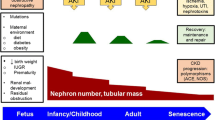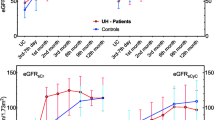Abstract
Background
Posterior urethral valves (PUVs) account for 17% of pediatric renal failure. The management of pregnancies involving fetuses with PUV is hampered by the fact that current clinical parameters obtained from fetal ultrasound and/or fetal urine biochemistry are insufficient to predict postnatal renal function. We previously have developed a fetal urine peptide signature (12PUV) that predicted with high precision postnatal renal failure at 2 years of age in fetuses with PUV. Here, we evaluated the accuracy of this signature to predict postnatal renal outcome in fetuses with PUV in an independent single-center study.
Methods
Thirty-three women carrying fetuses with suspected PUV were included. Twenty-five fetuses received vesicoamniotic shunts during pregnancy. PUV was confirmed postnatally in 23 patients. Of those 23 fetuses, 2 were lost in follow-up. Four and 3 patients died in the pre- and perinatal periods, respectively. Follow-up renal function at 6 months of age was obtained for the remaining 14 patients. The primary outcome was early renal failure, defined by an eGFR < 60 mL/min/1.73 m2 before 6 months of age or pre- or perinatal death.
Results
The peptide signature predicted postnatal renal outcome in postnatally confirmed PUV fetuses with an AUC of 0.94 (95%CI 0.74–1.0) and an accuracy of 90% (95%CI 78–100). The signature predicted postnatal renal outcome for the suspected PUV cases with an AUC of 0.89 (95%CI 0.72–0.97) and an accuracy of 84% (95%CI 71–97).
Conclusions
This single-center study confirms the predictive power of the previously identified 12PUV fetal urinary peptide signature.



Similar content being viewed by others
References
Agarwal S (1999) Urethral valves. BJU Int 84:570–578
Hodges SJ, Patel B, McLorie G, Atala A (2009) Posterior urethral valves. ScientificWorldJournal 9:1119–1126
Krishnan A, de Souza A, Konijeti R, Baskin LS (2006) The anatomy and embryology of posterior urethral valves. J Urol 175:1214–1220
Morris RK, Quinlan-Jones E, Kilby MD, Khan KS (2007) Systematic review of accuracy of fetal urine analysis to predict poor postnatal renal function in cases of congenital urinary tract obstruction. Prenat Diagn 27:900–911
Morris RK, Malin GL, Khan KS, Kilby MD (2009) Antenatal ultrasound to predict postnatal renal function in congenital lower urinary tract obstruction: systematic review of test accuracy. BJOG 116:1290–1299
Hogan J, Dourthe ME, Blondiaux E, Jouannic JM, Garel C, Ulinski T (2012) Renal outcome in children with antenatal diagnosis of severe CAKUT. Pediatr Nephrol 27:497–502
Stevenson DK, Goldworth A (1998) Ethical dilemmas in the delivery room. Semin Perinatol 22:198–206
Lantos JD, Warady BA (2013) The evolving ethics of infant dialysis. Pediatr Nephrol 28:1943–1947
Klein J, Bascands JL, Mischak H, Schanstra JP (2016) The role of urinary peptidomics in kidney disease research. Kidney Int 89:539–545
Schanstra JP, Zurbig P, Alkhalaf A, Argiles A, Bakker SJ, Beige J, Bilo HJ, Chatzikyrkou C, Dakna M, Dawson J, Delles C, Haller H, Haubitz M, Husi H, Jankowski J, Jerums G, Kleefstra N, Kuznetsova T, Maahs DM, Menne J, Mullen W, Ortiz A, Persson F, Rossing P, Ruggenenti P, Rychlik I, Serra AL, Siwy J, Snell-Bergeon J, Spasovski G, Staessen JA, Vlahou A, Mischak H, Vanholder R (2015) Diagnosis and prediction of CKD progression by assessment of urinary peptides. J Am Soc Nephrol 26:1999–2010
Pontillo C, Jacobs L, Staessen JA, Schanstra JP, Rossing P, Heerspink HJL, Siwy J, Mullen W, Vlahou A, Mischak H, Vanholder R, Zurbig P, Jankowski J (2017) A urinary proteome-based classifier for the early detection of decline in glomerular filtration. Nephrol Dial Transplant 32:1510–1516
Decramer S, Wittke S, Mischak H, Zurbig P, Walden M, Bouissou F, Bascands JL, Schanstra JP (2006) Predicting the clinical outcome of congenital unilateral ureteropelvic junction obstruction in newborn by urinary proteome analysis. Nat Med 12:398–400
Drube J, Zurbig P, Schiffer E, Lau E, Ure B, Gluer S, Kirschstein M, Pape L, Decramer S, Bascands JL, Schanstra JP, Mischak H, Ehrich JH (2010) Urinary proteome analysis identifies infants but not older children requiring pyeloplasty. Pediatr Nephrol 25:1673–1678
Schanstra JP, Mischak H (2015) Proteomic urinary biomarker approach in renal disease: from discovery to implementation. Pediatr Nephrol 30:713–725
Klein J, Lacroix C, Caubet C, Siwy J, Zuerbig P, Dakna M, Muller F, Breuil B, Stalmach A, Mullen W, Mischak H, Bandin F, Monsarrat B, Bascands J-L, Decramer S, Schanstra JP (2013) Fetal urinary peptides to predict postnatal outcome of renal disease in fetuses with posterior urethral valves (PUV). Sci Transl Med 5:198ra106
Schwartz GJ, Munoz A, Schneider MF, Mak RH, Kaskel F, Warady BA, Furth SL (2009) New equations to estimate GFR in children with CKD. J Am Soc Nephrol 20:629–637
(1997) World Medical Association declaration of Helsinki. Recommendations guiding physicians in biomedical research involving human subjects. JAMA 277:925–926
Neuhoff N, Kaiser T, Wittke S, Krebs R, Pitt A, Burchard A, Sundmacher A, Schlegelberger B, Kolch W, Mischak H (2004) Mass spectrometry for the detection of differentially expressed proteins: a comparison of surface-enhanced laser desorption/ionization and capillary electrophoresis/mass spectrometry. Rapid Commun Mass Spectrom 18:149–156
DeLong ER, DeLong DM, Clarke-Pearson DL (1988) Comparing the areas under two or more correlated receiver operating characteristic curves: a nonparametric approach. Biometrics 44:837–845
Buffin-Meyer B, Klein J, van der Zanden LFM, Levtchenko E, Moulos P, Lounis N, Conte-Auriol F, Hindryckx A, Wühl E, Persico N, Oepkes O, Schreuder M, Tkaczyk M, Ariceta G, Fossum M, Parvex P, Feitz W, Olsen H, Montini G, Decramer S, Schanstra JP, ANTENATAL Consortium (2019) The ANTENATAL multicenter study to predict postnatal renal outcome in fetuses with posterior urethral valves: objectives and design. Clin Kidney J. https://doi.org/10.1093/ckj/sfz107
Buffin-Meyer B, Klein J, Breuil B, Muller F, Moulos P, Groussolles M, Bouali O, Bascands JL, Decramer S, Schanstra JP (2018) Combination of the fetal urinary metabolome and peptidome for the prediction of postnatal renal outcome in fetuses with PUV. J Proteome 184:1–9
Boizard F, Brunchault V, Moulos P, Breuil B, Klein J, Lounis N, Caubet C, Tellier S, Bascands JL, Decramer S, Schanstra JP, Buffin-Meyer B (2016) A capillary electrophoresis coupled to mass spectrometry pipeline for long term comparable assessment of the urinary metabolome. Sci Rep 6:34453
Nassr AA, Shazly SAM, Abdelmagied AM, Araujo Junior E, Tonni G, Kilby MD, Ruano R (2017) Effectiveness of vesicoamniotic shunt in fetuses with congenital lower urinary tract obstruction: an updated systematic review and meta-analysis. Ultrasound Obstet Gynecol 49:696–703
Dreux S, Rosenblatt J, Moussy-Durandy A, Patin F, Favre R, Lortat-Jacob S, El Ghoneimi A, Oury JF, Deschenes G, Ville Y, Heidet L, Muller F (2018) Urine biochemistry to predict long-term outcomes in fetuses with posterior urethral valves. Prenat Diagn 38:964–970
Acknowledgement
SD and JPS are members of the European Reference Network for Rare Kidney Diseases (ERKNet)– Project ID No 739532.
Funding
The study was supported by Polish Mothers Memorial Hospital Research Institute (internal grant number 2016/IV/54-GW), by the “Fondation pour la Recherche Médicale” (grant number DEQ20170336759) and by the “Agence de la Biomédecine” (METAPhOR project).
Author information
Authors and Affiliations
Corresponding author
Ethics declarations
Conflict of interest
JS is an employee of Mosaiques diagnostics GmbH (Hannover, Germany) that markets urinary peptide-based diagnostics products.
Additional information
Publisher’s note
Springer Nature remains neutral with regard to jurisdictional claims in published maps and institutional affiliations.
Electronic supplementary material
Supplementary Table 1
Normalized abundance of each of the ~5616 fetal urinary peptides in each sample. (XLSX 1115 kb)
Rights and permissions
About this article
Cite this article
Buffin-Meyer, B., Tkaczyk, M., Stańczyk, M. et al. A single-center study to evaluate the efficacy of a fetal urine peptide signature predicting postnatal renal outcome in fetuses with posterior urethral valves. Pediatr Nephrol 35, 469–475 (2020). https://doi.org/10.1007/s00467-019-04390-9
Received:
Revised:
Accepted:
Published:
Issue Date:
DOI: https://doi.org/10.1007/s00467-019-04390-9




